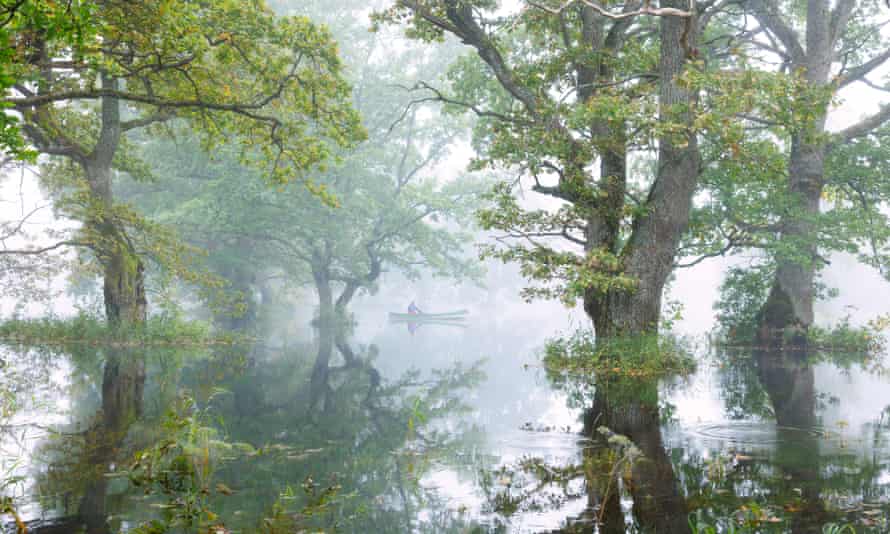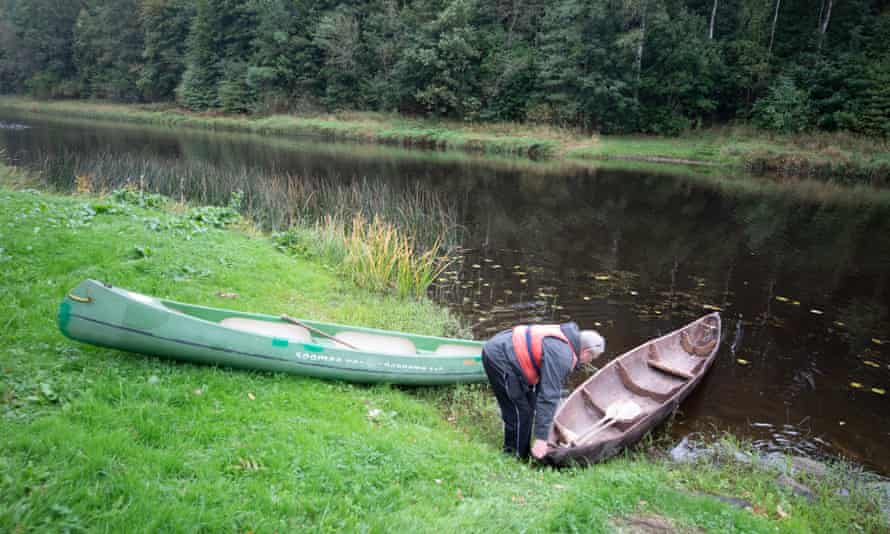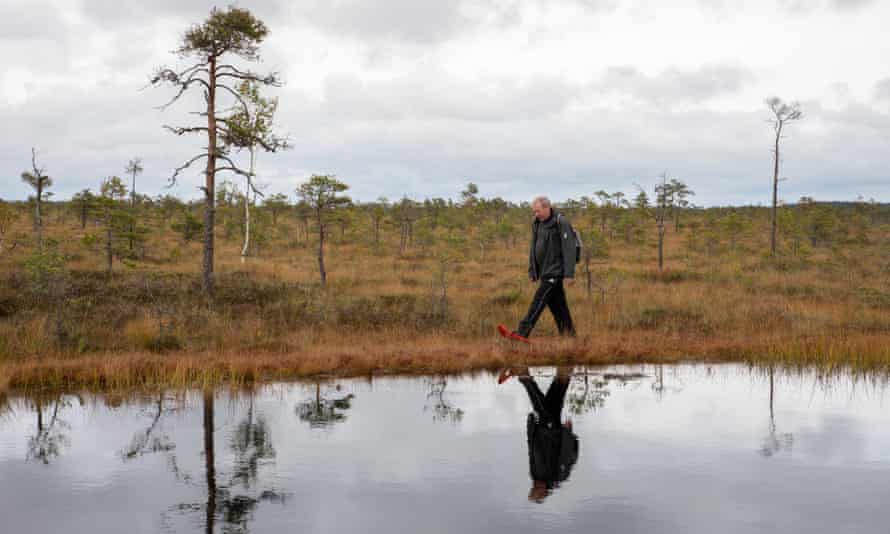Ahead, the jellied earth sways. As I approach a natural pool at the edge of a wide, wild expanse in central Estonia, the bog feels untrustworthy, if not quite menacing. This far into the Soomaa national park, the ground is so unsure of itself that even trees have given up. My guide, Aivar Ruukel, tells me that it’s not the same animals – wolves and bears are among the creatures that patrol these lands, hoping to find a meal trapped in the mire.
Elsewhere in this wilderness there are elk and raccoon dogs. Recently, wolverines from the north have been spotted, too. “People have been seeing golden jackals,” says Aivar, “and normally they are in Turkey.” The reason for this extraordinary menagerie is, perhaps inevitably, linked to Estonia’s low human population. Despite being slightly larger than the Netherlands, Estonia has about 7.5% of its population, making it one of the most sparsely populated nations in Europe. In Soomaa, it’s easy to believe these stats.
The north of the country – Tallinn and the Baltic Sea coast – was a lot busier, but even in Pärnu, a thriving coastal spa town with a yawning beach and colourful wooden houses, things already felt as though they were thinning out. While in summer it booms with domestic tourism, in autumn and winter it’s sleepy. But I was seeking more isolation still, and so I found myself with Aivar.
His company, Soomaa, specialises in tours of the national park after which it is named. He offers night safaris and multi-day adventures, but I’ve signed up for a day trip, which starts with a paddle along the Navasti river on the edge of the park in a canoe painstakingly fashioned by Aivar from a local aspen. Graceless ducks splash-land nearby as we paddle upriver, while tiny fish leap from the water, desperately trying to escape murderous pike below. From the high reeds on the riverbank, an inscrutable grass snake looks on.

Before venturing into the park, we tuck into lunch at Aivar’s home – a lavish spread of fruits and vegetables grown on the property. While we eat, Aivar describes the problems of hunting, the pressure development is putting on the national park and, more than anything, the glory and goodness of the peat bogs that cover a lot of Soomaa. These, he insists, are primordial, magical places, where flora and fauna have adapted to create something special – and visiting in the colder months adds another dimension to the mystery.
Soomaa roughly translates to “mireland” or “land of bogs”, neither of which sound particularly elegant, even if they are technically accurate. It conjures images of the flatulent stepping stones in Labyrinth’s “Bog of Eternal Stench”, and the word bog is still regularly used in my Scottish home town to mean toilet. Perhaps “water meadow” or “aqua glade” is easier on the ears, I suggest.
“You’ll see when we get there,” says Aivar confidently. “It’s a very beautiful place, very quiet. A wild place, but also delicate.” There has been a lot of talk of nature healing or “rewilding” over the past couple of years, but in this ecosystem, growth and regrowth happen very slowly. “Peat grows just one millimetre a year,” says Aivar.
Cutting or burning peat releases carbon, and the park ensures that the peat contained within it won’t be harvested; mercifully, Estonians tend not to use it as a fuel source these days. Aivar has other concerns about land management, but he’s not about to give me a grim lecture, so we head off to explore.

I follow him through some dark woods while he drops a trail of bog-related facts, like Hansel or Gretel. They’re not uninteresting, but it’s quite hard to focus on statistics about which percentage of Estonia is designated as wetlands – it’s 20% – when the undergrowth is so astonishingly fungal. I’ve never seen quite so many mushrooms as on the damp forest floors of Soomaa.
Beyond the trees, the sodden plains ahead mostly comprise sphagnum or peat moss, which looks fairly solid but has the consistency of jelly. In the depths of winter this all freezes then dramatically thaws when it is joined by spring rains to create a “fifth season”. As the riverbanks burst, open bogs turn into lakes, and this is the time of year Aivar gets most use out of his canoes.
Now, though, to avoid sinking into the squidgy ground, we strap on cumbersome red plastic ‘bog shoes’ (basically snowshoes). “A couple of times people have gone into the bog and got pulled out,” says Aivar. “In 15 years, we’ve lost two shoes. Maybe three. Perhaps one day archaeologists will find them and be very confused.” He adds that these boots were first found to be effective on the land by goose-hunters, cranberry foragers “and maybe guys visiting girlfriends on the other side of the bog”.

High acidity and water retention mean that boglands aren’t good hosts for trees. A loose forest of aspen, birch and spruce stops abruptly, looking out across the expanse like protesters at a disciplined rally. While mushrooms dominate darker parts of the woods, towards the edge berries come to the fore: blue-, bil-, cloud-, cow-, cran- and even crow-, but no rasp-. Almost all these berries can be used for jams, says Aivar, eating whichever late-season stragglers he finds on low-lying branches.
We head out across the open bogs. As well as being eerily beautiful, the place is also notably silent. Once we get going, however, there’s no ignoring that it’s a great landscape for onomatopoeia: slurp, squidge, slop and, more than anything, squelch. A few established wooden walkways snake across the land, but wearing the shoes and going off-piste is so much more fun, even if I have the approximate gait and grace of a drunkard.
After half an hour or so, we stop at a large natural pool. Like many people, Aivar has become a convert to wild swimming over the past year, and he’d like to give it a try here. I meekly suggest that I don’t have any swimming shorts with me, but my guide is already disrobing, telling me he has towels and not to worry.
As I begin to strip off, trying to ignore the upsetting whiteness of my thighs, he comments: “They say doing this gives you an extra year of life.” Then, as magnificently naked as the day he was born 54 years ago, he adds “I’m actually 172,” and disappears into the cold, coppery water. For a second, I consider running away, but this wild playground is far from civilisation – and my bog shoes are no use for sprinting.




